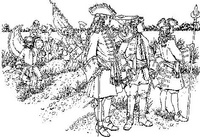By John T. Marck

Leonard Calvert was
born in 1610, the second son of George Calvert, first Lord Baltimore, and his
wife, Anne Mynne. His eldest brother was Cecilius Calvert, second Lord
Baltimore, and the first proprietor of the province of Maryland.
Although Leonard's brother Cecilius was the first proprietor of Maryland, he never visited there. As his presence was needed in England to defend his charter from repeated attacks, Cecilius entrusted the exercise of his authority to Leonard.
Much of Leonard's early life is little-known. It is recorded that in 1628, at the age of twenty-two, Leonard traveled with his father to Newfoundland, then returned to England where he petitioned the king for letters of marque. A letter of marque is a document issued by a nation that allows a private citizen to seize citizens or goods of another nation or to equip a ship with arms to attack enemy ships.
On behalf of Cecilius, Leonard sailed from Cowes, England with two ships, the Ark and the Dove on November 22, 1633. With him on this voyage was his brother, George, and about three hundred colonists. After a long voyage, they arrived at St. Clements Island, in Maryland, and went ashore on March 25, 1634. Today, March 25th is celebrated as Maryland Day. It was here that Leonard took "solemn possession of the Country for our Saviour and for our Sovereign Lord the King of England."
About one month later, after many days of exploring and establishing friendly relations with the Indians, Leonard established the seat of government at St. Mary's City in St. Mary's County, Maryland. On instructions he had received from Cecilius on November 15, 1633, before his journey on the Ark and the Dove, Leonard addressed himself as governor, and further had the authority to appoint two commissioners to assist him. He was further instructed to give no offense to the Protestant members of the colony, and to develop friendly relations with Virginia.
As governor, Leonard was granted many powers. On April 15, 1637, Leonard received his first commission as governor, by which he was made commander-in-chief of all armed forces by land and sea; was made chief magistrate with a large power of appointment; was authorized to call, prorogue, and dissolve the legislative assembly; was made the chancellor and chief justice with full authority to hear and determine all criminal and civil cases not involving life, member, or freehold, and grant pardons. Further, he was authorized to grant patents for lands and designate places for ports of entry, and markets.
Governor Calvert gave special attention to the encouragement and regulation of trade with the Indians. In the summer of 1634, he sent the Dove to Boston with a cargo of corn to trade for fish and other products. He called the first Assembly of freemen to meet at St. Mary's in 1635, and those laws that they passed were sent to Cecilius the proprietor, for his approval. Cecilius rejected them and sent others in their place for approval by the second assembly. In January, 1637, all the members of the Assembly, except Governor Leonard and his secretary of the province, voted against them. A suggestion was made that some laws be agreed upon until the proprietor again responded. Leonard's reply to this was that the Assembly had no such power to take this action. Finally, he gave in to a proposal that stated that he govern during this period according to the laws of England, and if necessary, by martial law. Because of this, forty-two bills were passed. Governor Leonard signed the bills, and wrote to Cecilius saying, "I am persuaded they will appear unto you to provide both for your honor and profit as much as those you sent us did." Cecilius, as proprietor gave in and the right of initiative in the legislation passed to the Assembly. This became the first important step in the conversion to popular government in Maryland.
In February 1638, Governor Calvert leading a small force, caused the compliance of a trading post on Kent Island that William Claiborne had established there in 1631.
In 1642, Leonard Calvert married Anne Brent, the daughter of Richard Brent and Elizabeth Reed. Together they had two children: William Calvert, who was born in 1643, and died May, 1682 in Baltimore County, Maryland; and, Anne Calvert, born in 1645.
In 1643, Leonard sailed to England to confer with his brother. Upon his return in September 1644, William Claiborne and Richard Ingle incited a rebellion of Protestants against the Catholics. In this, St. Mary's City was confiscated, causing Governor Leonard to take refuge in Virginia. In 1646, Leonard returned with a force of Virginians and Marylanders, and regained possession of St. Mary's City, and restored order.
Leonard Calvert died on June 9, 1647. He left two children, William and Anne, by his wife, Anne Brent, who had died years before. In the days that preceded his death, Leonard made his sister-in-law, Margaret Brent his executrix. In this position she possessed the powers to look after his estate, and pay the soldiers Leonard had hired to recover St. Mary's City.
Leonard Calvert was a hard working man, and very faithful to his brother's interests. He did lack in diplomacy and governed mostly by force rather than leadership.
Copyright ©
1990-2022 by John T. Marck. All Rights Reserved. This article and their accompanying pictures, photographs, and line art, may not be resold, reprinted, or redistributed for compensation of any kind without prior written permission from the author.